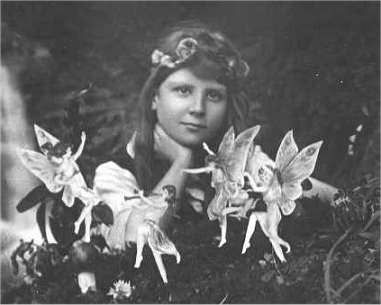“Fairies
at Work and Play: Observed by Geoffrey Hodson” is a peculiar book, first
published in 1925. I have a 1947 reprint edition. The author was a prominent
member of the Theosophical Society Adyar and the Liberal Catholic Church. The
introduction to his book is written by Edward L Gardner, another leading
British Theosophist. The book comes with a kind of imprimatur from C W
Leadbeater, one of the two top leaders of the international Theosophical
movement. Both Hodson and Gardner were heavily involved in the Cottingley
Fairies affair, which most people today consider to have been an elaborate
hoax. Hodson actually visited Cottingley and claimed to have seen a lot of
fairies there, using his clairvoyance. These claims obviously sound dubious in
hindsight!
In “Fairies at Work and Play”, the Cottingley Fairies are mentioned only in passing. Instead, Hodson reveals the results of other clairvoyant investigations around Britain and in Switzerland. While they are interesting, I don´t think skeptics will be particularly impressed by this material. For starters, many of the fairies look like the fake Cottingley Fairies, which in turn resemble fairies from children´s books. The fairies are often small and delicate, female in form, and have wings. Traditional fairy lore, however, does *not* portray fairies like this. The fairies encountered by the author are usually benign, while traditional lore regards them as frequently malevolent. Another type of fairy seen by Hodson is the stereotypical gnome, complete with a funny hat and beard. As behooves a Theosophist, Hodson sometimes see beings which doesn´t seem to have any equivalent in folklore. Rather, they “must” exist according to Theosophy. Thus, he encounters enormous human-like “gods” sitting on top of mountains, meditating and radiating a powerful aura. He also sees the “national deva” of Switzerland. There are times when Hodson is downright Freudian – his description of the play of the sea-spirits sound suspiciously similar to female orgasm?! When the old hypocrite has calmed down, he describes a fanciful Druid ritual in which the high priest calls down paranormal divine energies on the congregation, physically rejuvenating them.
What can
we “learn” about fairies from this book? Most are oblivious to the activities
of man, and seem to live in an Eternal Now of perfect joy. They are connected
to the life forces of plants, to clouds or to the waters. Some imitate the
actions of humans, for instance by building “houses” or pretending to “sleep”
in beds, but this is done without real knowledge of what these activities are really
all about. The fairies have hierarchies, with the smaller “mannikins” following
the commands of larger and more evolved specimens. And yes, sometimes they
dance… I admit that there are certain general similarities between these
observations (or whatever they are) and later reports about aliens from outer
space or Men in Black. Aliens and MIBs often act in baffling ways, as if they
didn´t know how humans should act, they have hierarchies with the smaller ones
taking orders from larger ones, etc. Occasionally, Hodson admits (and Gardner concurs)
that the forms taken by the fairies aren´t their actual ones, the fairy really
being a sphere of light or something similar. Likewise, the “houses” built by
them is glamour. I suppose a true believer would argue that the fairies appeared
to Hodson in a form he was accustomed to…
“Fairies
at Work and Play” is probably a somewhat tedious read if you´re looking for the
equivalent of paranormal action flicks, but it could be of some interest to
people interested in folklore, not because it´s folkloristic sensu stricto, but
because it shows us how folklore was adapted by a Theosophist and incorporated
into that worldview. It´s also interesting as a tie-in to the Cottingley Fairy
Photos.

Det har ju skett en uppenbar mentalitetsförändring på 100 år. Idag skulle väl knappast någon vid sina sinnens fulla bruk argumentera för att bilderna på Cottingley-fairies var äkta. Det publiceras bilder på fairies än idag, men de ter sig betydligt mer "realistiska"...
ReplyDeleteJag får intrycket av att folk helt enkelt *ville* tro att de var äkta, just för att de motsvarade den förutfattade meningen om hur "älvor" ska se ut. Sedan kanske folk hade en tendens att tro för mycket på fotografier, ungefär som man senare trodde på allt TV visade, eller allt som finns på nätet?
ReplyDelete